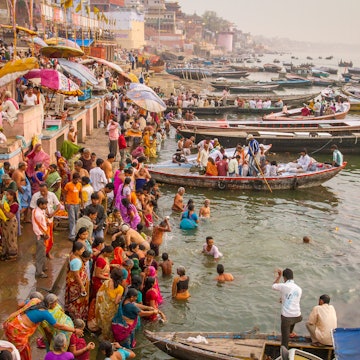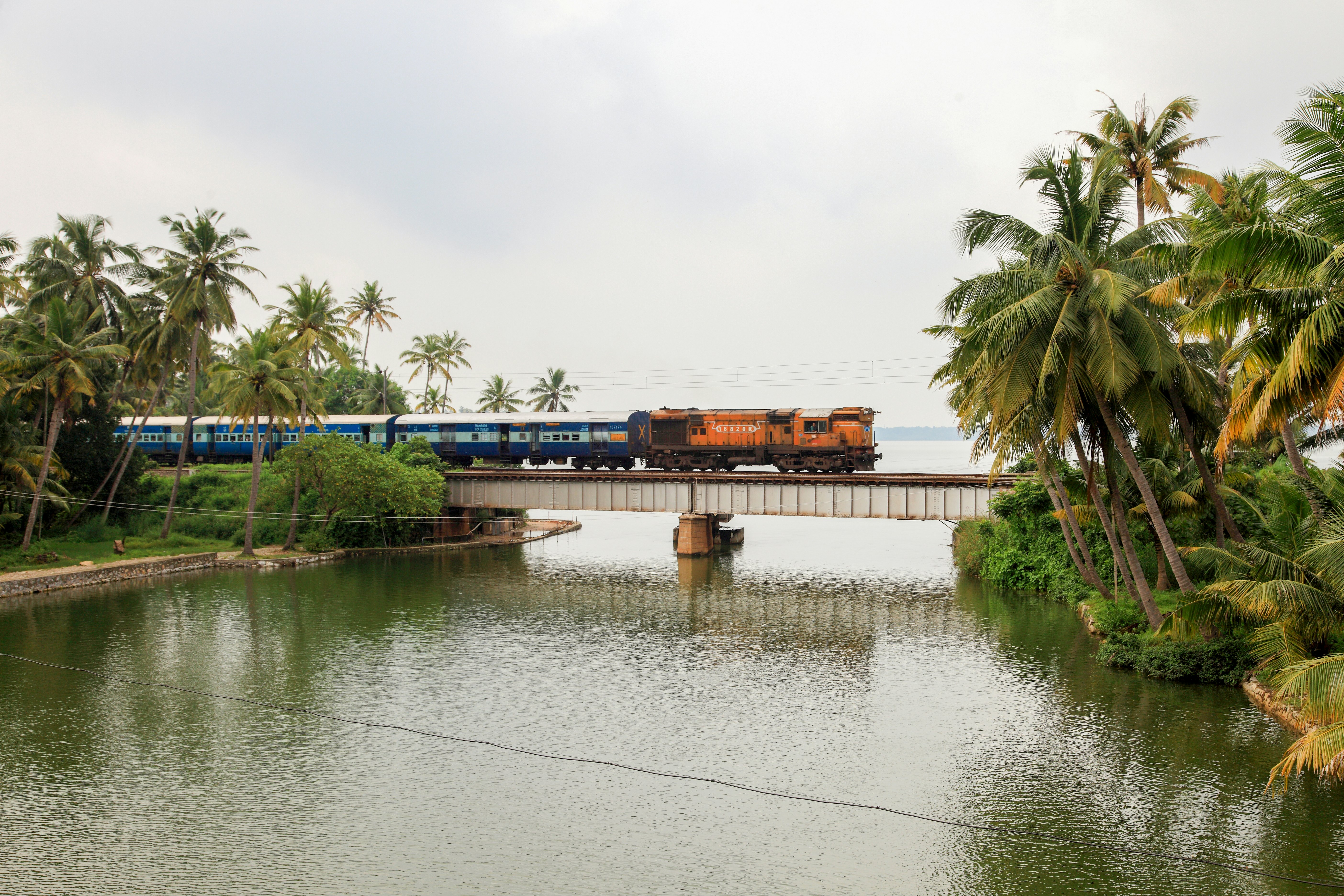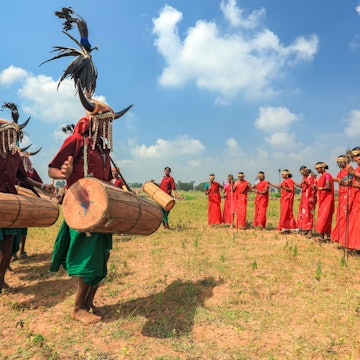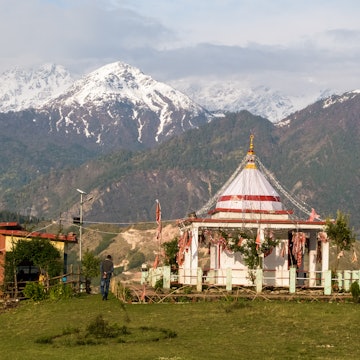

From jungle-covered peaks to beautiful beaches, Kerala is the Indian state with everything. andrijosef/Shutterstock
Green, humid and fragrant with spices, captivating Kerala is a world apart from the dry plains and lofty mountains of north India. Deity-covered gopuram towers crown the state's temples, menus are alive with seafood and local spices, and houseboats weave through the backwaters between historic port cities and beaches spilling from emerald jungles.
The list of things to do in Kerala is almost endless. You could roam across the rugged Western Ghats in search of elephants, tigers and hornbills, indulge the senses at a luxury Ayurvedic resort, or cruise the sleepy waterways inland from Alleppey (Alappuzha) in a traditional Keralan rice barge.
To start the adventure, try this 10-day itinerary taking in the best of Kerala, starting from historic Kochi (Cochin).
When to arrive
Kerala is warm year-round, with temperatures rarely dipping below 28°C (82°F), but the annual monsoon rains from June to September can have a big effect on your travel plans. The best time to visit is from October to March, when the temperatures are moderate and the skies are blue.
The dry months from December to March see the biggest crowds, and the highest prices during the Christmas holidays; visit from October to November for a quieter experience. Visitor numbers also drop as temperatures rise in April and May, before the monsoon arrives to cool things down.
Note that some restaurants, hotels and other tourist-facing businesses close during the monsoon, particularly at beach resorts such as Kovalam and Varkala.

How to get around
Kochi has a busy international airport, served by direct flights from destinations across Asia and the Middle East, as well as flights from other Indian cities. It’s also easy to reach Kerala overland, with regular long-distance buses and fast trains running to hub stations such as Ernakulam Junction (for Kochi), Alleppey (for the backwaters) and Thiruvananthapuram (Trivandrum).
Trains connect most destinations along the coast, passing through some stunning scenery, but buses or a chartered car and driver are the easiest ways to explore areas inland. Take a houseboat cruise, boat tour or public ferry to explore the famous backwaters near Alleppey. Taxis, autorickshaws and Ola and Uber rideshares are handy ways to get around Kerala’s bigger cities.
What to pack
Swimwear should be reserved for Kerala’s beaches – pack a sarong or light cotton pants and a shirt or tee to pop on once you leave the sand to avoid causing offense. When visiting religious sites, wear something that covers the legs and upper arms.
You’ll need some sturdy footwear for trips into towns and national parks, particularly in the Western Ghats, where long socks will help keep off leeches while hiking. Bring sandals or flip-flops to kick off at temple chappal (sandal) stands or the water’s edge. You’ll also want a warm layer for the cooler nights in the highlands.
Bring sunscreen, a sun hat, and plenty of mosquito repellent, plus a plug-in mosquito killer or mosquito net in case your accommodation doesn’t provide one. Also bring a refillable water bottle so you can top up from hotel supplies of filtered water rather than buying bottled water and creating unnecessary rubbish.

Days 1-2: Absorb Kerala’s rich history in Kochi
How to spend the days: After arriving in Kochi, most visitors make a beeline for the old part of the city, where you can see the clear imprint of the Portuguese, Dutch and British empires. Start your explorations in Fort Cochin, a laid-back neighborhood where murals adorn the streets and heritage buildings have been reborn as cool cafes, chic shops and galleries, and boutique hotels.
Take a stroll along the waterfront near Vasco da Gama Square and you’ll spot Kerala’s unofficial emblem – cantilevered cheenavala (Chinese-style fishing nets) first introduced to Kerala in around 1400 CE by Chinese traders from the court of Kublai Khan.
A famous center for traditional Keralan art forms, Kochi is also a dynamic hub for contemporary art. Much of the scene revolves around Fort Cochin, where colorful murals adorn crumbling heritage buildings and artists showcase their work at cafes, museums and galleries.
Investigate the artworks at the pioneering Kashi Art Gallery and browse the shows at galleries set in old Dutch buildings, such as Idha, David Hall, Lila Art Cafe’s Kazhcha Gallery, or visit Mattancherry’s Gallery OED, set in a converted pepper warehouse.
Plan for long, lazy lunches in Kochi. Over two days, you can graze the menus at cozy spots such as artwork-filled Kashi Art Cafe, cafe-meets-yoga-studio Loving Earth Cafe and garden-set Qissa Cafe and Pandhal Cafe & Deli. Alternatively, take the experience upmarket in the French Toast cafe at the Cochin Club or the Armoury Restobar at the heritage, harborside Brunton Boatyard hotel.

On day two, delve into Kochi’s history at the Mattancherry Palace, a graceful mix of European and Kerala-style nalukettu architecture. The highlight is the collection of intricate Hindu murals depicting stories from the Ramayana and Mahabharata and legends from the Puranas.
Continue the history tour in the area known as Jew Town, where you’ll find the wonderfully preserved Pardesi Synagogue (closed Friday afternoon and Saturday), with an elaborate brass bimah (prayer platform) surrounded by Belgian chandeliers, Murano-glass lamps and hand-painted Chinese willow-pattern tiles.
To discover more about the many cultures that have coexisted in Kochi for centuries, join a storytelling walk or bike tour with Kochi Heritage Project, exploring Mattancherry’s multicultural identity.
Evening: After dark, make for Mattancherry’s Ginger House for tasty cashew-paneer curry and pachakari stew served in an antiques-filled warehouse. Neema’s Kitchen, just over the water from Fort Cochin on southern Vypeen Island, serves three-hour-long Keralan feasts in a 1930s bungalow.
Use one evening to take in a performance of Kathakali – traditional Keralan dance-drama featuring vividly colorful costumes and make-up. Fort Cochin’s long-running Kerala Kathakali Centre hosts introductory two-hour performances, as well as hands-on workshops unveiling the artistry behind Kathakali make-up.

Days 3-4: Dive into Kerala’s tropical interior
Go to Munnar or Periyar: Regular buses leave from Ernakulam’s busy bus stand to the hill resort and tea town of Munnar (five hours) or Kumily, the closest town to Periyar Tiger Reserve (six hours).
How to spend the days: A two-day detour inland will take you into the green wonderland of the Western Ghats, home to myriad wildlife species and lush tea and spice plantations. As an added perk, the highlands are refreshingly cool compared to the steamy coastline.
For highland hikes and emerald tea plantations, head to Munnar, perched among rolling hills at 1524m (5000ft) at the meeting point of three rivers. Often cloaked in patches of swirling mist, the rugged mountain landscapes here evoke everything that makes the UNESCO-listed Western Ghats so magical.
Explore the surrounding peaks on a guided trek with a local trekking agency. Take your pick from gentle dawn walks to catch the sunrise to more ambitious hikes to lookouts such as 2650m (8694ft) Meesappulimala, Kerala’s second-highest peak.
Some 250 working tea plantations dot the hills near Munnar, painting the hills in green swirls. Founded in 1879, Lockhart Tea Factory is one of Kerala’s oldest estates, and its current owners offer guided tours exploring how tea is picked, processed and exported. Consider spending the night in a nostalgic tea planter’s bungalow at CGH Earth Lockhart.

If seeing wild elephants is on your bucket list, head to Kumily to explore the verdant jungles of Periyar Tiger Reserve. Around 2000 elephants and 40 elusive tigers wander the forests here, along with langur monkeys, wild boar, giant squirrels, sambar deer, Indian bison, otters and more.
Cruises on glinting Periyar Lake are a popular way to explore, and you may spot colorful bird species on the water and otters, bison, deer and elephants on the lakeshore. This is also one of the few Indian reserves where visitors can explore on foot. On treks led by Adivasi (Indigenous) guides, you can roam the jungle for a few hours or take overnight camping trips deeper into the forest.
The park’s signature hike is the two to three-day Periyar Tiger Trail, with hikes led by retrained former poachers, but don’t overlook shorter walks such as the full-day Border Hike, visiting mountain viewpoints on the edge of the reserve, and after-dark Jungle Scout sessions.
Evening: Munnar and Kumily both have plenty of good places to eat. In Munnar, try the local branch of veggie favorite Saravana Bhavan, or more meat-oriented Ali Baba & 41 Dishes. In Kumily, pick Ebony’s Cafe or Chrissie’s Cafe for terrace or courtyard dining, or graze the upscale buffet at Tamarind in the Spice Village resort.

Days 5-6: Drift through the Alleppey backwaters
Go to Alleppey: Buses run to Alleppey (Alappuzha) from both Munnar and Kumily, taking five to six hours.
How to spend the days: Travelers flock to the coastal city of Alleppey to take a cruise on Kerala's famous backwaters – a network of village-dotted lakes, rivers, canals and lagoons tracing the coastline as far north as Kochi and as far south as Kollam. It’s one of the best places to soak up the timeless mood of the Keralan countryside.
One less touristy way to see the backwaters is to take the public ferry across vast Vembanad Lake to Kottayam – a journey of around 2½ hours in each direction, passing through waters that throng with boats, edged by sleepy backwater villages and gently swaying palms.
For the classic overnight backwater cruise on a kettuvallam – a houseboat based on a modified traditional rice barge, with meals cooked on board – seek advice from other travelers or hotels in Kochi, Munnar or Kumily about recommended operators.

Transporting you away from the noise and hubbub, a typical two-day cruise involves dramatic sunsets and sunrises, freshly cooked Keralan meals, glimpses of South Indian birdlife, and the chance to drift along the waterways, visiting backwater villages to see traditional industries such as coir (coconut fiber) making and toddy-tapping.
If you don’t want to devote two days to an overnight cruise, consider a day tour by canoe, kayak or paddleboard with an operator such as Nanni Tours & Travels or Moksha Stories. You can use the second day to explore the local area – there’s an attractive beach at Marari, about 14km (8.7 miles) north of Alleppey, and good bird-watching at the Kumarakom Bird Sanctuary, about 35km (22 miles) northeast.
Evening: If you take an overnight cruise, you’ll eat delicious Keralan food on your houseboat. If not, Alleppey is well-stocked with restaurants. Try Halais for fragrant biryanis, Cafe Catamaran for beachfront traveler fare, Thaff for Keralan thalis (plate meals), or the Raheem Residency’s Chakara restaurant for upscale fish dishes.

Days 7-8: Soak up the rays on Varkala’s beaches
Go to Varkala: It’s just two hours by train from Alleppey to Varkala – a faster option than taking the bus.
How to spend the days: Varkala's sunny sands and sacred sights are well worth two days of your time.
Backed by rust-colored cliffs, the town’s powdery gold-black beaches
are washed by some of South India’s finest surf waves. Varkala has long
been Kerala’s go-to backpacker beach spot, but it’s also an important
Hindu pilgrimage destination.
On day one, focus on the surf and sand. Busy Papanasam Beach is the main focus for sunseekers, and also a sacred spot for Hindu pilgrims, but there are several smaller, quieter coves, such as Black Beach (Thiruvambady Beach) and Odayam Beach to the north of the North Cliff.
If you feel the call of the waves, local surf shops rent surfboards and boogie boards and offer classes and multi-day courses. The main surfing season runs from October to April – well-established Soul & Surf is a dreamy retreat perched on Varkala’s South Cliffs, offering stylish accommodation, rooftop yoga and surf classes and courses for guests and drop-ins.

Continue in the same vein on day two, or book in for an Ayurvedic treatment session at AyurSoul near Varkala’s North Cliff. Or, if you’re feeling brave, take a tandem paragliding flight with Can Fly Adventure, coming in to land on Varkala’s golden beach (flights run December to April).
Use the rest of the day for spiritual pursuits or more wellbeing, such as a yoga class or meditation session in front of the clifftop view. Discover Varkala’s sacred side at the Janardhana Temple, devoted to Vishnu as Janardana the Protector, dating back to the 13th century.
Only Hindus are permitted to enter the main shrine, but the shrine-studded grounds are open to everyone. Many pilgrims continue down to Papanasam Beach to perform puja (prayer) rituals and bathe in the sea, whose waters are believed to wash away sins.
Evening: Two evenings means double the dinner indulgence. There are easygoing traveler joints such as Soul Food Cafe and Cafe TripisLife, relaxing terrace dining at ABBA and Darjeeling Cafe, and authentic thali and Keralan curry houses in Varkala Town, such as Chimney Family Restaurant and Suprabhatham.

Days 9–10: Find history in Trivandrum and serenity in Kovalam
Go to Thiruvananthapuram (Trivandrum) and Kovalam: To reach Kovalam from Varkala by bus or train, you need to change in the state capital, Trivandrum (one hour), worth a stop in its own right for its interesting museums and temples.
How to spend the days: En route to Kovalam, devote half a day (or longer) to Trivandrum's historic Fort area, once the powerhouse of the Kingdom of Travancore. Here you’ll find the gopuram-topped, 18th-century Shri Padmanabhaswamy Temple, fusing Keralite and Dravidian elements, and the Puthe Maliga Palace Museum, set in the former royal residence.
Other top museums in town are dotted around the Zoological Gardens. Dive into history at the dramatic Napier Museum, packed with bronzes, wood-carvings and stone sculptures, and the similarly rich Keralam Museum, then discover the artworks of Keralan painter Ravi Varma at the Raja Ravi Varma Art Gallery.
Aim to reach Kovalam by mid-afternoon, so you have time to hit the beach. Much of the fun revolves around pretty Lighthouse Beach, a broad sandy strip overlooked by candy-striped Vizhinjam Lighthouse (climb it for sprawling panoramas). It’s a popular surf spot too; community-focused Kovalam Surf Club offers board rental and classes.

The next day, you can hop across the Tamil Nadu border to visit the exquisite Padmanabhapuram Palace (closed Monday), the former royal seat of the princely state of Travancore and the greatest surviving example of traditional Kerala wooden architecture, with its most ancient sections dating from 1550. It’s best reached by chartered car.
Alternatively, book in for a refined treatment plan at a stylish Ayurvedic resort such as Somatheeram, overlooking Chowara Beach about 7km (4.3 miles) southeast of Kovalam, or Niraamaya Retreats Surya Samudra and Bethsaida Hermitage in Pulinkudi.
Evening: Lighthouse Beach is a lively hub for dining in Kovalam – try Suprabhatham or Varsha Hotel for authentic local meals, or head to Waves or Fusion for more globe-trotting fare. For dinner with a view, eat at Curry Leaf, looking out over Samudra Beach, or dress up to dine in the posh restaurants at the Leela or at Taj Green Cove.
This article was adapted from Lonely Planet’s India guidebook, published in November 2024.
















